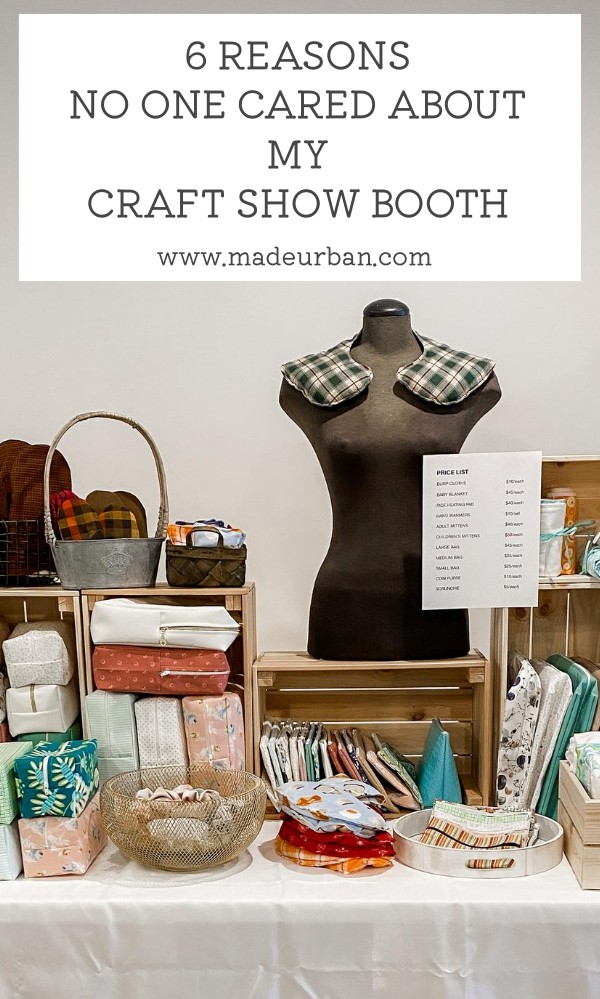6 Reasons No One Cared About my Craft Show Booth
When I watched the majority of craft show shoppers walk by my table, I knew I had to make some changes.
Here are the mistakes I discovered I was making.

1 – I put zero effort into marketing
I believed craft show organizers were solely responsible for marketing an event and that I just had to show up and shoppers would line up at my table.
Event organizers will cast a wide net when marketing. Meaning, they’re not targeting people who will be perfect for your business. They’re targeting people who enjoy buying handmade items.
So it’s important that you share the event with your social media followers, newsletter subscribers, past customers, and friends and family so that you know people who are specifically interested in your products will be at the show.
>> How to Promote a Craft Show (as a vendor)
2 – I didn’t advertise to craft show shoppers
What I mean by “advertise” is, I didn’t turn my booth into a clear message that would draw shoppers in.
Advertising piques your interest.
If you can’t pique a craft show shopper’s interest enough to get them to stop at your table, you can’t make sales.
Advertising also has a clear message.
When you see a commercial or ad for McDonald’s, they’re trying to pique your interest with something specific. They’re not saying “come in for some food”; they’re suggesting you come try a Big Mac.
Your craft show table shouldn’t say: “Here’s a bunch of stuff I made.”
It should have a clear message, such as:
“Come pick out a new handbag.”
“Come get some pretty hand soap that smells like flowers.”
“Come over and shop for some jewelry for the holidays.”
If your table is trying to say all three, you’re likely losing shoppers.
3 – My table had a low perceived value
My craft show table looked very “crafty” and not like a trustworthy and legitimate business.
>> My products didn’t have tags or packaging.
>> I had hand-written signs taped up.
>> I didn’t have a brand, so nothing was on-brand; fixtures, tablecloth and props were mismatched and disjointed.
I was charging for handmade items (i.e. higher than average prices), but the elements that surrounded those high-priced products lowered their perceived value.
I needed to put just as much attention and effort into every detail of my business and its display.
4 – I was following the leaders
When I showed up at my first craft show, I had no idea how to build a successful booth. I didn’t know what to fill it with, I didn’t know how to display items, I didn’t know what to say…
So I watched other vendors in the room.
My business partner at the time and I noticed a vendor selling bags was busy for the majority of the show. So we decided to introduce bags at our next event.
Although we were far from copying their bag designs, we weren’t staying true to the idea that sparked our craft show business; flannel pyjama bottoms & heating bag gift sets.
I still wonder what direction we would have gone in if we had focused on that product and built around it, rather than scattering in several different directions
Don’t be afraid to be different and forge your own path.
No one has the answers; everyone’s figuring it out as they go. And typically, the vendors who stay true to themselves, trust their intuition, and don’t try to please everyone by going in several different directions, end up with the most successful businesses.
5 – I didn’t find my target market
I had no idea who I was creating products for. I was simply making what I felt like making and hoping people would buy it.
Some people did buy, but not nearly as many as when I got clear on my target market.
I started with a product, then went looking for people to buy it.
Start with a group of specific people you want to serve, then make products for them.
Examples of specific groups of people are:
- Travellers
- Brides
- New homeowners
- People with a popular and specific style (e.g. bohemian)
- Dog owners
- Etc.
6 – I didn’t listen to my market
When I wasn’t making sales or attracting shoppers, I needed to take that feedback in.
Consumers were saying, “I’m not interested in what you’re selling.”
People may say they love your work, but if they don’t love it enough to buy, something has to change.
Pay close attention to which items your target market is drawn to and what seems to be the element that encourages or discourages them to buy.
Give it time
Don’t make big changes based on one craft show. Slowly get a feel for who you want your target market to be and the products they’re interested in, then add and subtract one or two products at a time.
Small business growth doesn’t happen overnight. So be patient.

Hey, I’m Erin 🙂 I write about small business and craft show techniques I’ve learned from being a small business owner for almost 2 decades, selling at dozens of craft shows, and earning a diploma in Visual Communication Design. I hope you find my advice helpful!
